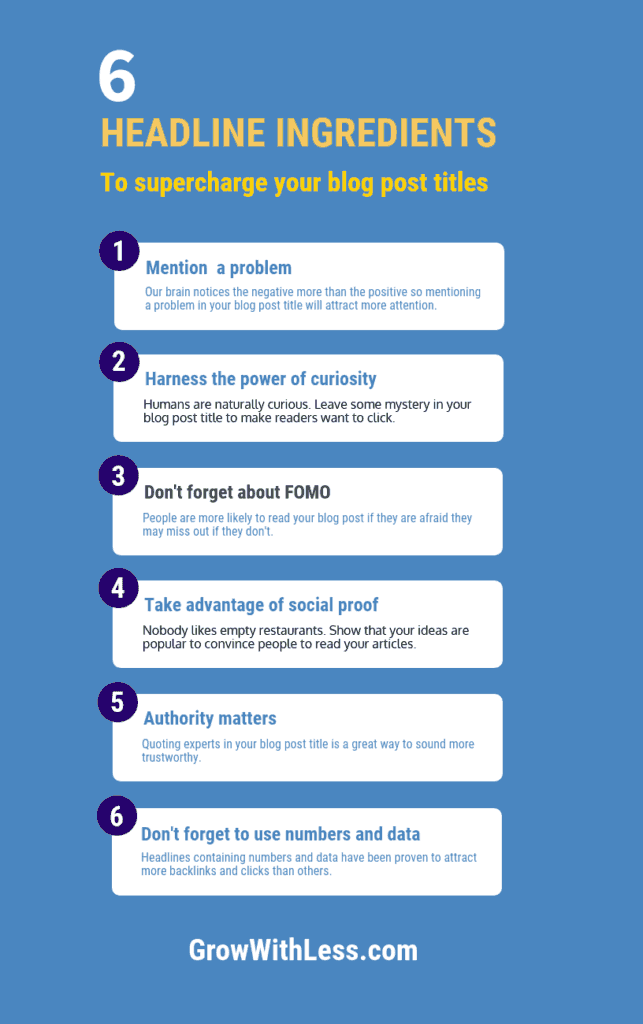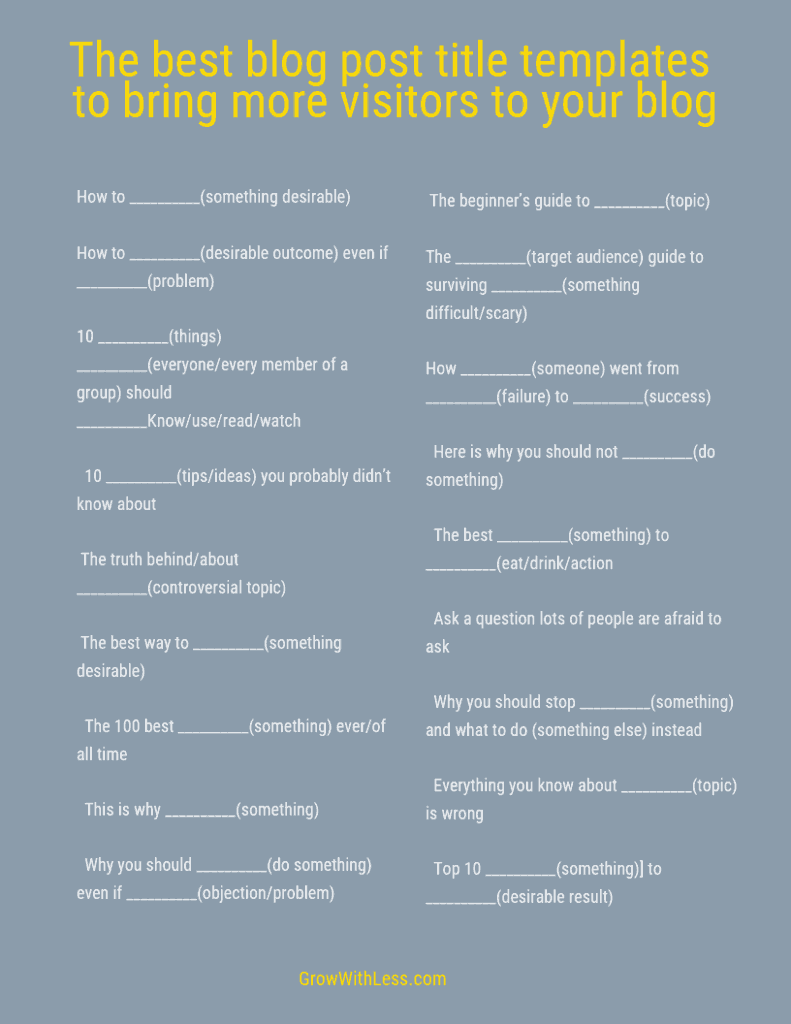Copywriting legend David Ogilvy once said that “on the average, five times as many people read the headline as read the body copy. When you have written your headline, you have spent eighty cents out of your dollar.”
That’s great news because it means a great blog post title has the power to attract lots of readers to your blog and to help you build your business.
Unfortunately, it also means that nobody will read your article if the blog title sucks. Luckily, creating a great blog post title is not as hard as it may seem.
Here is how to come up with a great blog post title, avoid common mistakes and why using headline templates can be dangerous.
Research before writing your blog post title

Imitating successful headlines is a bad idea unless you have the exact same audience. A blog post title that worked on another blog may not work on yours. That’s why research is essential.
The internet is full of fill-in-the-blank headline templates that promise to help you create amazing blog post titles in seconds.
And while I love to look at blog post title templates for inspiration, using them right away is a costly mistake because a headline that performs well on another website won’t necessarily perform well on yours.
The secret to a high-performing blog post title isn’t the best template but a deep understanding of your audience.
Just look at these 2 blog post titles:
- 50+ Delicious Dessert Recipes That Won’t Kill Your Diet - Delish.com
- 30 of Our Most Outrageously Decadent Dessert Recipes - Bonappetit.com
The first blog post title targets people who are trying to lose weight while the second headline targets people looking for decadent recipes. While the second recipe would perform well on lots of food blogs, it would be a terrible blog post title to use if your audience is people looking for healthy recipes.
That’s why I recommend taking a few minutes to think about your audience before blindly using a blog post template or imitating the headline of a viral article your competitor wrote.
To get started, simply:
- Read the comments of blog posts that rank well for your keyword in search engines.
- Go to your niche’s subreddit, forums and Facebook groups and search for threads discussing the topic of your article.
- Look at the search results for the keywords you want your article to rank for.
You will quickly notices patterns and find the answers to questions such as:
- What problems do people face?
- What are they frustrated with?
- What do they expect from the article?
- What is their intent when they google the keyword the article is trying to rank for?
- What are their hopes and dreams?
- What emotions are they feeling?
For example, here are a few interesting comments I found in a Reddit thread about “how to do planks.”
When I had to do planks for sports in school, we were taught to bend our arms at the elbow and do the plank resting on our forearms. What’s your opinion on this method, versus what you’ve shown here?
Maybe you could take a stance in your blog post title and explain why the traditional way of doing planks that we are all taught at school is wrong.
I’ve been progressing my planks steadily, but they are easily one of my least favourite exercises.
You could say that your article about planks will turn planks into the reader’s favorite exercise.
I had shoulder surgery last year and have been advised by my physio to do all pushing movements with a retracted scapula, to provide additional support for my shoulder.
If you article helps people who have injuries, this is something you could mention in your headline to differentiate yourself from all the basic “how to do planks” tutorials.
The goal at this point is simply to observe and take notes. Research may sound like a waste of time but it will guarantee that your blog post title doesn’t end up attracting the wrong audience.
Supercharge your blog title with proven headline ingredients

If you look at the most shared articles on the web, you will quickly notice that they almost all use the same basic ingredients.
- Problems.
- Curiosity.
- FOMO.
- Social proof.
- Authority.
- Data and numbers.
These are ingredients you should add to your blog post titles because they make them much more likely to be clicked and shared.
Magic headline ingredient #1: problems
Turn on your TV and you are likely to see plane crashes, floods, economic crisis…Not a single happy event in sight.
It’s not because nothing good happens in the world.
It’s because our brain has a negativity bias which means that it notices negative events more than positive events.
In fact, Tversky and Kahneman’s 1981 Asian disease problem has shown that problems have an extraordinary ability to catch our attention and get us to stop doing whatever we are doing.
And that’s exactly what you want your headlines to do. You want to write headlines so good that the reader will notice them in a sea of blog post titles and immediately click to read your articles.
When writing a blog post title, ask yourself the following questions:
- Is this article solving a particular problem?
- Is there a way I could highlight it in the blog post title?
- Is there a negative consequence to not following the advice given in the article?
If the answer to any of those questions is yes, try to mention a problem in your headline in order to make it more remarkable.
Here are a few examples of headlines featuring problems:
- Can’t Do a Pull-up Yet? Here’s How to Get it Done – Nerd Fitness
- The Bitcoin bubble could be about to burst – The Motley Fool UK
Magic headline ingredient #2: curiosity
We have all read spammy blog post titles that promise to show us how to earn thousands of dollars in 48 hours.
Every time I see such a blog post title, I’m torn because I know the article will be a let-down but also really want to click in case it’s not and actually contains a useful piece of information.
That’s the power of curiosity in a headline.
Curiosity drives lots of human behaviors and curiosity blog titles work because they create an open loop we absolutely need to close. We need to see what’s hiding behind the curtain.
To add curiosity to my blog titles, I like to ask myself the following question:
- What’s the most intriguing part of the article?
- What’s one aspect that will surprise people?
- What’s one thing that surprised me when I wrote the article?
Beware though, curiosity can easily make your site look like a British tabloid so make sure you avoid overused phrases such as “you will never guess what happened…”
If you need inspiration, here a few great curiosity headlines I found:
- I went paleo and now I hate everything – Everywhereist
- What a revolutionary Ramen restaurant can teach us about designing better websites – Wholegrain Digital
- 50 Cent accidentally made $8 million in bitcoin – The Verge
Magic headline ingredient #3: FOMO
If there is one fear that goes hand in hand with curiosity, it’s the fear of missing out (FOMO.)
We click on curiosity headlines because we want to know what’s behind the curtain while we click on FOMO headlines because we are afraid we may miss out on some key information if we don’t.
This makes the fear of missing out a powerful blog post title ingredient.
If you know that people would genuinely miss out by not reading your article, you can add a dash of FOMO to your blog post title to make readers want to click.
To write FOMO headlines, ask yourself the following questions:
- Is there anything I reveal in the article that would give the person knowing it an advantage over others?
- Is there any deadline associated with the content of the article?
- Will the reader miss out by not reading the article now?
Here are a few FOMO headlines for inspiration:
- 17 Underrated Shows On Netflix You’re Totally Missing Out On – Buzzfeed Compress images now or forever push site visitors away – Appsumo
Magic headline ingredient #3: social proof

Imagine you just arrived in the lovely Italian city of Florence. You are hungry and decide to look for a nice restaurant.
You don’t know anything about the place and don’t speak Italian.
In front of you are 2 restaurants. One is full of people talking and eating a pizza Margherita while there is only one person in the other one.
Which one do you choose?
If you are like most people, you choose the restaurant that is full. Not because it’s inherently better but because you assume it’s popular for a reason and there must be something wrong with the empty restaurant.
That’s social proof in action and you can use for all kinds of purposes, from nudging hotel guests to reuse towels to writing better blog post titles.
To write social proof headlines, ask yourself the following questions:
- Is the information you reveal in the article used by lots of people?
- Would your reader be an outlier by not reading it?
Here are a few examples of blog post titles using social proof:
- 1 In 4 Facebook Users Delete Facebook App As Millennial Exodus Continues – ZeroHedge
Magic headline ingredient #5: authority
Authority works similarly to social proof. We are more likely to eat in a restaurant a famous chef or a friend recommended than in an unknown restaurant.
That’s why TV commercials regularly feature celebrities and authority figures. If dentists say that this toothpaste is the best, then it must really be the best because they are expert and know what they are talking about.
Quoting an expert in a headline makes it sound more trustworthy. If people regularly see an expert mentioned on a website, they will associate you with this expert.
To harness the power of authority in your blog post titles, ask yourself the following questions:
- Did I mention a well-known person or group in the article?
- Is what you recommend in the article something a respected group (doctors, lawyers…) does or recommend?
Examples of blog titles using authority include:
- What toothpaste do YOU use? Dentist reveals what to look for – Daily Mail
- 3 Warren Buffett ratios that could help you retire a millionaire – The Motley Fool UK
- How Tony Robbins Generates 1,000,000 Website Visitors Per Month – Sumo
- Facebook will lose 80% of users by 2017, say Princeton researchers – The Guardian
Magic headline ingredient #6: numbers and data

Blog post titles containing numbers and data have been proven to attract more backlinks and clicks than others with 10 being the highest performing headline number based on average social media share.
That’s because numbers have the power to increase credibility and make your article look more trustworthy.
Which blog post title would you trust the most:
- How I made a ton of money
- How I made 3,546,265 USD in 2018
To harness the power of numbers and data in your headlines, ask yourself the following questions:
- Did I mention specific numbers and data points in the article?
- Can I mention a specific time frame?
- Can I turn this article into a list post?
Here are a few examples of headlines using numbers and data:
- Fall Asleep Fast — In 2 Minutes or Less – Art of Manliness
- T Shirt Marketing (How I got $5,000 worth of Copywriting Clients from a $22 T-Shirt) – KopywritingKourse
Now that you know the 6 ingredients that help you write better headlines, it’s time to have fun and pick a headline template.
Pick a blog post title template

Picking a headline template is my favorite part of writing a blog post tile because it’s the moment when your hard work finally pays off and you get to create the perfect blog post title.
At this stage, it’s important not to get overwhelmed. If you have done your research and identified possible headline ingredients, you will immediately see which blog post title template would work well.
Simply look at my list of catchy headline formulas and write down any blog post title that comes to mind without worrying about how good it is.
After 5 minutes, you should have a decent list of blog post titles to choose from. Simply read them and choose the 3 that you consider the best.
Then read them out loud and pick one. You can also keep your 3 favorite blog post titles and run an A/B test.
Avoid common blog post title mistakes
You have a blog post title and it looks pretty damn good. So what do you do?
Publish it?
Not so fast!
I recommend checking your headline for common blog post title mistakes to make sure it doesn’t only look good but also performs well and doesn’t end up hurting your credibility.
Being too descriptive

Long descriptions are great for books, not for blog post titles.
The number one mistake I see bloggers make is to write purely descriptive headlines.
- Tomato soup
- New workout routine
- Reading in Spanish
These blog post titles are not the worst in the world, at least people more or less know what to expect but they don’t make you think “I need to read that immediately”.
That’s because these are not headlines, these are descriptions.
And as everybody knows, descriptions make people yawn, not click.
To avoid making this mistake, try to be more creative and to think about the part of your article that makes people want to read it.
What’s one thing that distinguishes your tomato soup recipe from other tomato soup recipes? Is yours more detailed, more cheesy, spicier? Do you use a secret ingredient? Does your article include a video?
It could be that you use a special variety of tomatoes, or maybe your recipe is particularly easy to make or uses a secret spice. Whatever it is, conveying that in your headline helps you turn a boring headline into an exciting headline people want to click.
Here are a few tomato soup headlines for inspiration:
Easy Three-Ingredient Tomato Soup Recipe
Inspired Taste
This headline isn’t incredibly exciting but it at least tries to appeal to readers who find tomato soup recipes too complicated by using the adjective “easy”.
To make it even more appealing, you could try to add even more detail:
Easy Three-Ingredient Tomato Soup
The Easy Three-Ingredient Tomato Soup Your Kids Will Actually Want to Eat
The Ultimate Grilled Cheese And Tomato Soup Bowl
Tasty.co
Here, “ultimate” implies that it’s not yet another tomato soup recipe. Plus there is grilled cheese, something few people can say no to.
This may sound simple but writing a good headline is often simply a matter of finding what makes your article unique and expressing it in a few words.
31 Jokes Only “Stranger Things” Fans Will Find Funny
Buzzfeed
Here, a purely descriptive headline like “31 hilarious jokes” becomes considerably better just because it’s more specific. Instead of targeting people who like jokes (ie: everyone), the writer decided to target a specific group “fans of Stranger Things.”
Targeting a specific group is a surefire way to create better blog post titles because, as humans, we love to feel part of a group.
Using clickbait

Clickbait headlines may attract readers but they will leave disappointed and never come back.
Clickbait headlines will bring hordes of visitors to your site but it comes at a price.
By definition, clickbait headlines overpromise and underdeliver which means that each click on a clickbait headline erodes the trust people have in your and site.
A clickbait blog post title is the equivalent of airlines promising flights for 5 euros, they will attract lots of people but most of these people will feel cheated when they land on your website and realize what you promised doesn’t actually exist.
That’s why it’s important to look at each blog post title you write and make sure you didn’t unintentionally promise too much.
During my headline experiment, I came up with the following headline for an article:
15 strange French sayings they don’t teach you at school
This headline sounds nice at first and uses curiosity well but I decided not to use it because I don’t actually know whether people learned the sayings mentioned in the article at school or not.
If a person clicks expecting new French sayings only to discover sayings they did, in fact, learn at school, they will have less trust in the site.
So unless your goal is to create the next viral sensation, make sure your headlines don’t overpromise.
Revealing too much

Make sure you don’t reveal too much in your headline or people won’t have a reason to click.
Clickbait headlines often work by overusing curiosity. They use phrases like “you will never guess what happens” to open a loop we are desperate to close.
The problem is that they always disappoint us.
But curiosity is a powerful force and it would be a shame not to harness its power just because a lot of people misuse it.
If your article contains something surprising or unexpected, make sure you mention it in the blog title.
But also be careful not to spill the beans.
If your blog post title contains all the information readers need to know, they won’t click to read your article.
Just compare these blog post titles. Which one would you be the most likely to click?
Soapwalla makes the best deadorant for women
This little-known brand makes the best deodorant for women
You may still click on the first headline if you don’t know Soapwalla or want to learn what makes the brand better but the key piece of information (what brand makes the best deodorant for women?) has been revealed in the headline so you have less of a need to click.
The second blog title, on the other hand, makes us want to click because we are desperate to know the name of the brand.
To grow more tomatoes, this man decided to water them more
Kind of a boring headline, don’t you think? There is nothing unexpected, and no reason to click.
But what if the headline had been:
One Man’s Genius Idea To Grow Tomatoes
Eat Local Grown
That’s much better.
If you are interested in growing tomatoes, you will click this headline because you are curious to see what the genius idea is.
Trying to be too clever
Every time I take the London Underground, I see ads with clever play-on-words and fun pictures.
The problem is that clever ads often lack clarity and confuse readers who are not familiar with the product.
The same is true for blog post titles. I love clever headlines that rely on puns and play on words but the fun factor shouldn’t come at the cost of clarity.
In the battle between clarity and cleverness, clarity wins every time because people rarely click on blog post titles that confuse them.
If people don’t understand your headlines, they will most likely move on and read another article or get distracted.
Ignoring SEO

You can use a Wordpress plugin like Yoast SEO to make sure your headlines are not too long for search engines.
Talking about search engines…
While it’s essential to craft blog post titles people want to click, neglecting search engines is a big mistake because people don’t click on headlines they don’t see.
The first step to writing a SEO headline is to try to include your keyword in the headline.
I say “try to” because it’s easier said than done and there are cases when adding your keyword will make the headline sound very unnatural.
In such cases, see if you can at least add a synonym. Google and other search engines have gotten smarter and it’s perfectly possible to rank without even mentioning a keyword provided that the topic of your article is clear.
For example, this page ranks second for “Learn French Online” even though the keyword isn’t written anywhere on the page.
Besides having a keyword in your headline, it’s important to make sure your headline isn’t too long for search engines results pages otherwise people will only see the beginning of it.
[Research by Moz](http:// https://moz.com/learn/seo/title-tag) indicates that 90% of headlines will show up properly in Google and other search engines as long as they are under 60 characters.
This number tends to change regularly so I recommend using a WordPress plugin like Yoast SEO to see how your headline is likely to show up in search engines.
Not measuring results
Writing catchy blog post titles is awesome but how do you make sure your headline is a great as you think it is?
You could use the proven headline ingredients and headline templates I just shared but there is still no guarantee that your headline will perform as expected.
That’s why I recommend A/B testing blog post titles. This process will help you prove your assumptions right and make sure that your headlines are indeed great.
Added bonus: the more time you spend A/B testing and looking at the results the better you will become at writing good headlines and predicting which headlines will perform best.
Being out of date

A while ago, a blog reader named John commented on one of my articles to tell me the dates were wrong.
I was confused and checked the article for mistakes.
That’s when I realized he was talking about the year listed in the blog post title.
I had written “2018” in my headline and forgotten to update it as the year changed. This may sound simple but that’s the kind of tiny mistake that could hurt you by making your site look out of date.
Writing a date in a headline is a great way to get more clicks but don’t forget to update the date.
Forgetting embarrassing typos
Having occasional typos in your article isn’t a big deal. In fact, I regularly see typos in articles I read online.
Problems start to arise when the typos you make change the meaning of the headline or confuse people
Just look at what happened when a newspaper forgot a hyphen.
https://twitter.com/LopezOnSports/status/924772252595433473
Now that you know how to create great blog post titles and avoid common mistakes, it’s time to get to work.
Download the free headline writing checklist and try to come up with at least 3 headlines for your article!